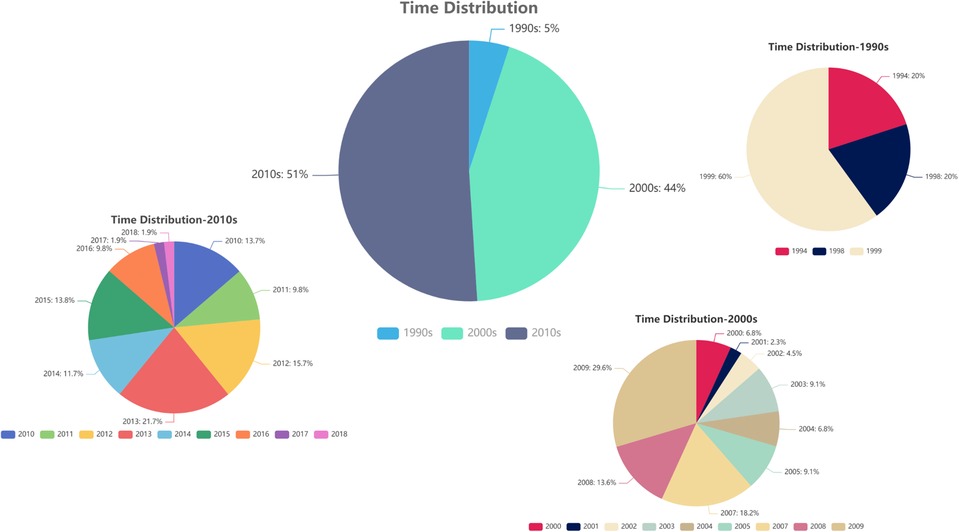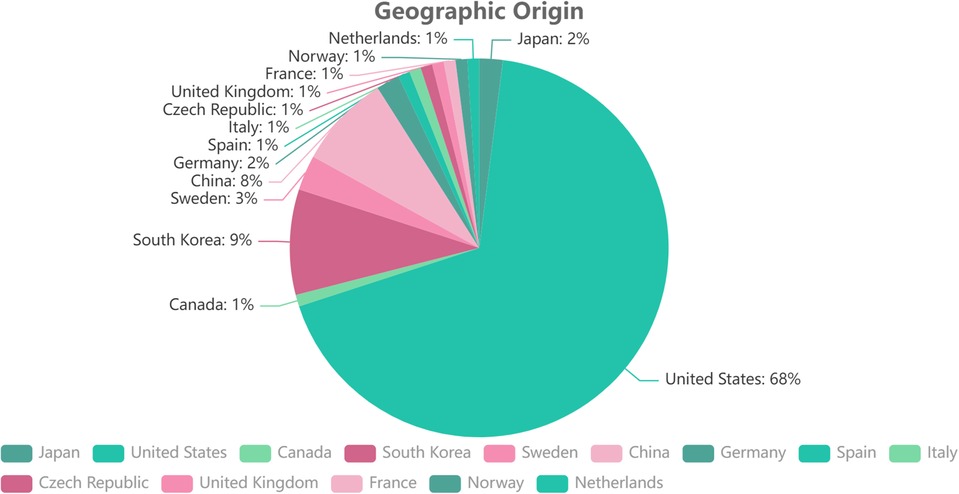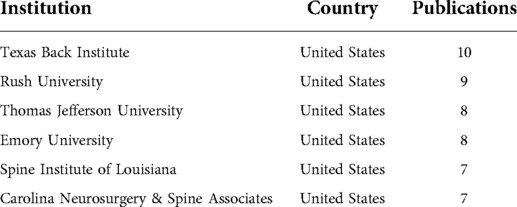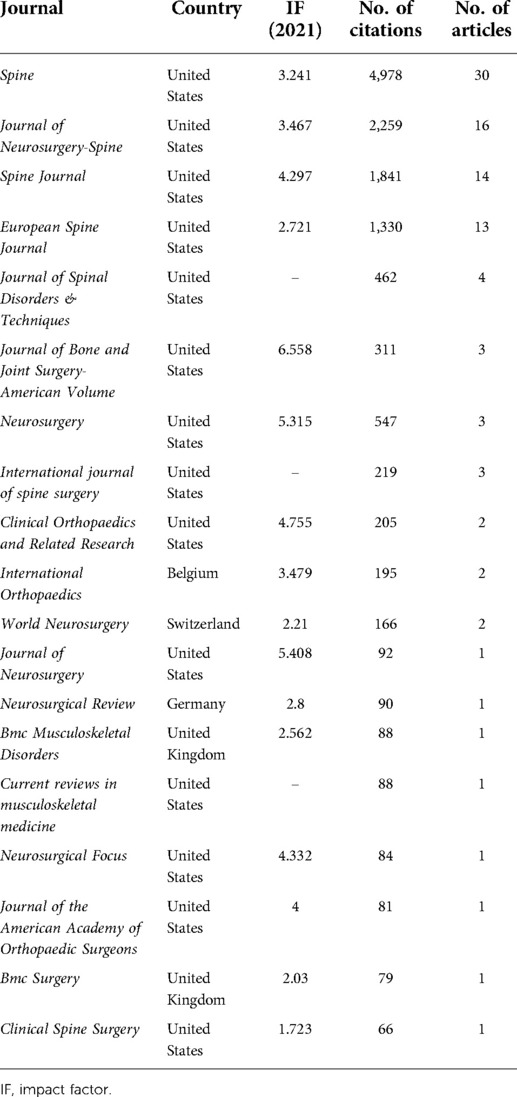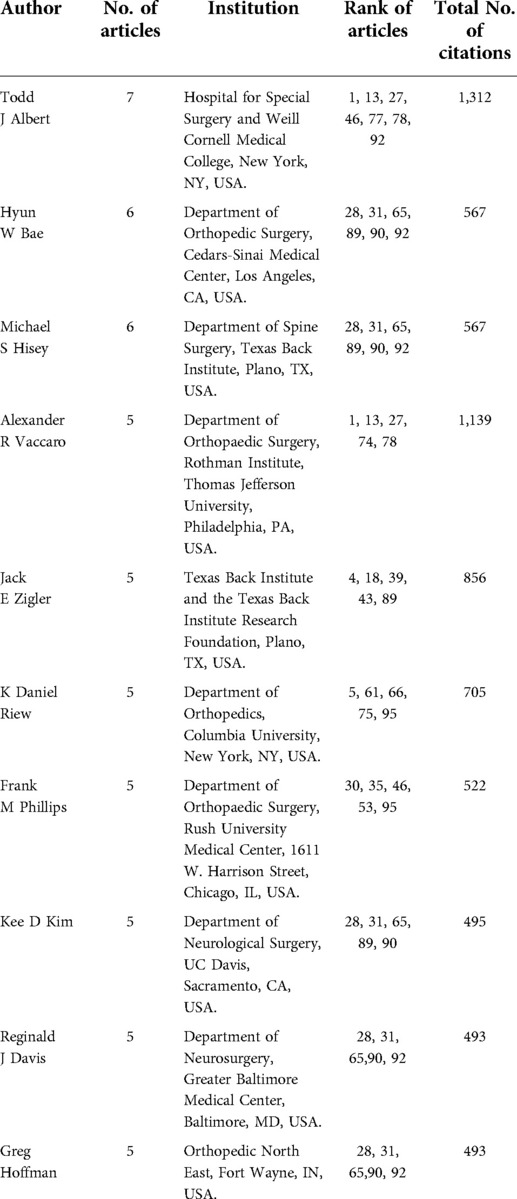- 1Department of Orthopaedics, The Third Xiangya Hospital, Central South University, Changsha, China
- 2Department of Neurology, Xiangya Hospital, Central South University, Changsha, China
- 3Department of Spine Surgery, The Third Xiangya Hospital, Central South University, Changsha, China
Study Design: Bibliometric analysis.
Objective: Anterior cervical discectomy and fusion (ACDF) is a typical surgical method in spine surgery and has progressed significantly in the last several decades. The purpose of this study is to determine how the 100 most-cited original articles on ACDF have been the most influential in this field by identifying and analyzing them.
Methods: The articles on ACDF were identified by searching the Thomson ISI Web of Science database on 30 May 2022. The 100 most-cited articles were selected according to specific criteria. The data extracted from the articles included title, publication date, total citations, journal name, first author, institutions, and keywords.
Results: The total number of citations was 13,181, with a mean number of 131.81 ± 100.18. The publication dates ranged from 1994 to 2018. Most of these articles originated in the United States (68%) and were published in the 2000s (32%) and 2010s (48%). Spine published most of the articles (30%), followed by the Journal of Neurosurgery-Spine (16%), Spine Journal (14%), and European Spine Journal (13%). The most prolific author was Dr. Todd J Albert (n = 7), with 1,312 citations. The Texas Back Institute was the most productive institution (n = 10). The keywords ACDF, cervical spine, cervical spine, and fusion showed the highest degree of centrality.
Conclusion: One hundred top-cited articles on ACDF were identified and analyzed in this study. We demonstrate that ACDF is a growing and popular area of research, with the focus of research varying through timeline trends. This will provide a comprehensive and detailed basis for spine surgeons to make clinical decisions and assimilate the research focus of cervical spine surgery.
Introduction
Degenerative Cervical Myelopathy (DCM) is the most common cervical spinal disease (1, 2). Its treatment has evolved from conservative treatment to cervical laminoplasty, posterior cervical laminotomy and fixation, and anterior cervical discectomy and fusion (ACDF), which was first reported by Cloward, Smith, and Ronbison in 1958, opening up a new frontier in cervical spine surgery (3, 4). In the subsequent 60 years, different shapes of the iliac crest bone graft were first used for interbody fusion, and as our understanding of the biomechanics of the cervical spine improved, more types of fusion devices were invited for ACDF (3–10). Since then, ACDF has been widely used in cervical spine surgeries worldwide. In the USA, the number of patients undergoing ACDF has increased from 31 per year in 2006, to 9,937 per year in 2016 (a 31,951.6% increase), and the average age of patients is on the rise (11). ACDF has been widely accepted and gained increasing attention in recent years, resulting in a plethora of research in the cervical spine field.
Reviewing past research is an important component in advancing each specific line of research. Bibliometrics is a cross-disciplinary science of quantitative analysis of all knowledge carried out through mathematical and statistical means (12, 13). Compared with traditional reviews and meta-analyses, in bibliometric analyses, quantitative analysis and statistics are used to estimate the structure and development of a specific scientific discipline (14).
In the past decades, many bibliometric analyses have been conducted to study the most cited articles and publications on ACDF or cervical spine surgery; however, the 100 most-cited articles on ACDF from 1950 to May 2022 remain to be elucidated (15, 16). In this study, we propose to use bibliometric methods to highlight the characteristics of the 100 most-cited articles on ACDF, especially in terms of research hotspots and focus. We hope that this study highlights the potential directions for future research on ACDF and cervical spine surgery.
Methods
Collection and allocation of data
We searched for all relevant articles on ACDF using the Web of Science database, including the Web of Science Core Collection, MEDLINE, KCI-Korean Journal Database, Russian Science Citation Index, BIOSIS Citation Index, and SciELO Citation Index. Two researchers independently identified articles for inclusion to enhance search sensitivity. The search terms were “anterior cervical discectomy and fusion” OR “ACDF” OR “anterior cervical and discectomy and fusion” OR “anterior cervical and discectomy and fusion” OR “anterior cervical decompression and fusion” OR “anterior cervical decompression and fusions” OR “anterior cervical disc fusion” OR “anterior cervical discectomy and interbody fusion” OR “anterior cervical discectomy fusion” OR “anterior cervical discectomy with fusion” OR “cervical discectomy with fusion”.
The search was performed on 30 May 2022. We obtained 2,900 articles in total, which contained all articles published from 1980 to the present. All results were sorted from highest to lowest number of citations. We exported articles with more than 50 citations to Endnote 20 (Thomson Corporation, USA) for further analysis. Two clinical doctors performed the review based on the inclusion criteria illustrated below, and the results were exported to an Excel spreadsheet. Each of the two reviewers identified the 100 most-cited articles by screening the full text. An experienced professor compared their results carefully screening for discrepancies, and the final results were generated after a group discussion for subsequent analysis.
Eligibility criteria
The inclusion criteria were: (1) basic science research, anatomic studies, animal research, and clinical research related to ACDF; (2) diagnosis, treatment, prognosis, or epidemiologic association with ACDF; and (3) original article, review, case report, editorial, clinical trial, and any other paper type closely connected with ACDF.
Data extraction
All the included articles were independently reviewed by the same two authors as above. The following information was recorded for all the articles: title, first author's name, journal name, year of publication, impact factor of the journal in 2021, total number of citations of the article, average citations per year, geographic origin, institutions, and author keywords.
Replicability and reproducibility
Replication means that people independent from the initial data extraction will simulate the search, while answering the same research question; whereas reproducibility means that the data analysis will be repeated by a person not involved in the first analysis to verify selection and quality of data. Both replicability and reproducibility were verified through the author not involved in the first search, and led to the same results, hence confirming the quality of the bibliometric analysis reported in this study.
Results
All the 100 most-cited articles are listed in Table 1 and arranged by citation rank. The total number of citations was 13,181 (mean ± SD, 131.81 ± 100.18). Of these, 7 articles were cited more than 300 times.
The publication time ranged from 1994 to 2018, and most articles were published in the 2010s (51%) and the 2000s (44%). Meanwhile, the articles published before 2000 only accounted for 5%, and the years with the largest number of articles were 2009 (n = 13) and 2013 (n = 11) (Figure 1).
The top 100 most-cited articles originated from 14 countries. The United States has the greatest number of published articles (n = 68), followed by South Korea (n = 9), China (n = 8), Sweden (n = 3), and Japan and Germany (n = 2, each). The Czech Republic, Canada, France, Italy, the Netherlands, Norway, Spain, and the United Kingdom each contributed one article (Figure 2). Regarding the institutional information, analyzed using VOSviewer, the most productive research institutions were the Texas Back Institute (TBI) and Rush University, followed by Emory University, Spine Institute of Louisiana, Carolina Neurosurg & Spine Associates, University of California San Francisco, Thomas Jefferson University, Cedars-Sinai Spine Center, and New York University. The remaining institutions are listed in Table 2 and Figure 3 according to the number of most-cited articles and published times. The cluster analysis of institutions is shown in Figure 3A, the different colors represent different clusters and the size of the spot indicates the number of institutions. Time-dependent overlay visualization of institutions is shown in Figure 3B.
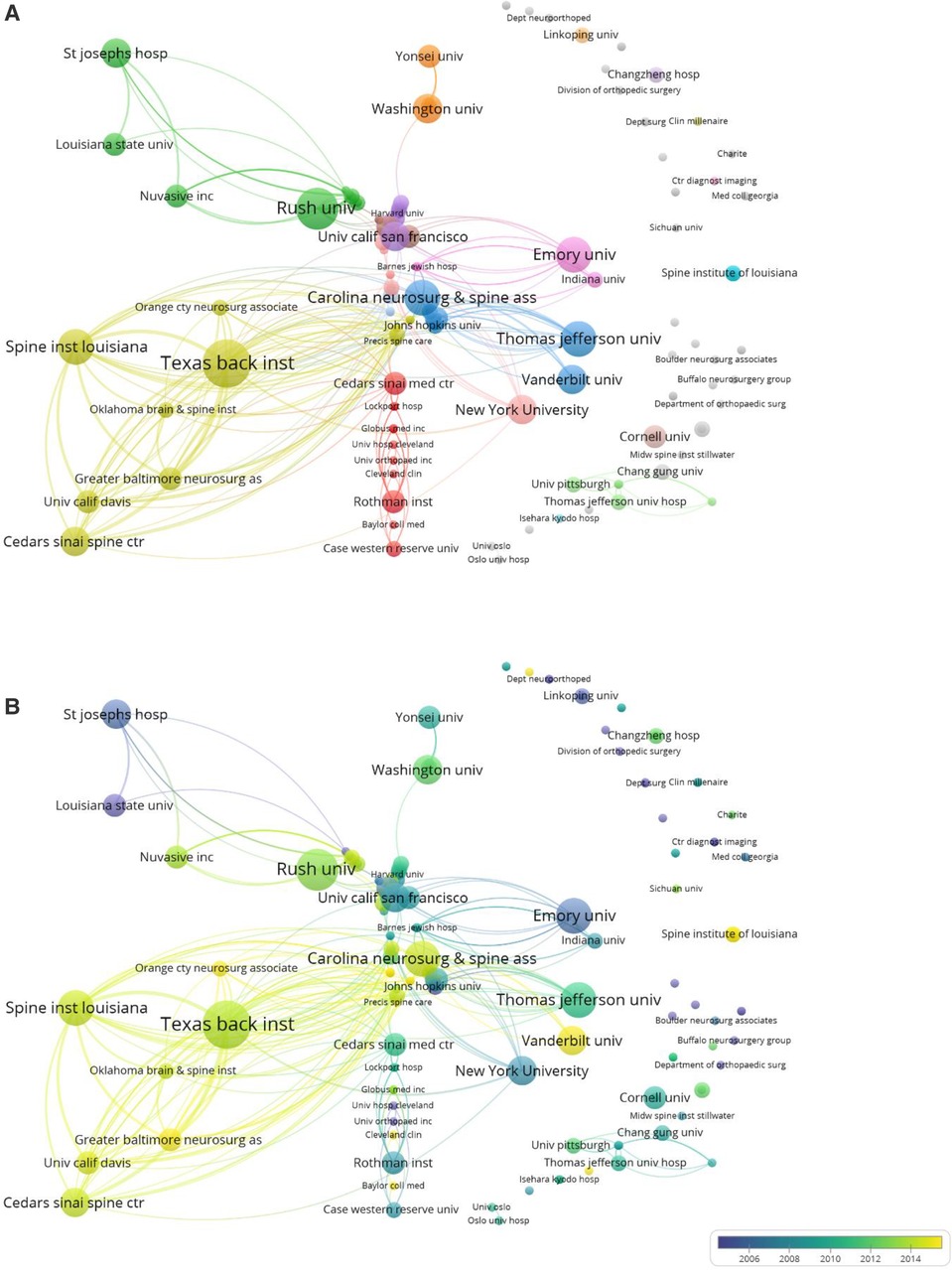
Figure 3. Degree of centrality analysis of the institutions of the whole 100 top-cited articles. (A) Overlay visualization. (B) Time-dependent overlay visualization.
All 100 top-cited articles were published in 19 journals, led by one of the most authoritative journals, Spine, which has the most publications (n = 30), followed by Journal of Neurosurgery-Spine (n = 16), Spine Journal (n = 14), European Spine Journal (n = 13), Journal of Spinal Disorders & Techniques (n = 4), and Journal of Bone and Joint Surgery-American Volume, Neurosurgery and International journal of spine surgery (n = 3, each); the remainder are described in Table 3. The journals and hotmap of publications were also analyzed using VOSviewer. The cluster analysis of the journals is shown in Figure 4A, where different colors indicate different clusters and the size of the spot indicates the number of articles in each journal. As for the hotmap in Figure 4B, the density of the yellow color indicates the number of articles published in every journal, showing the same result as above.
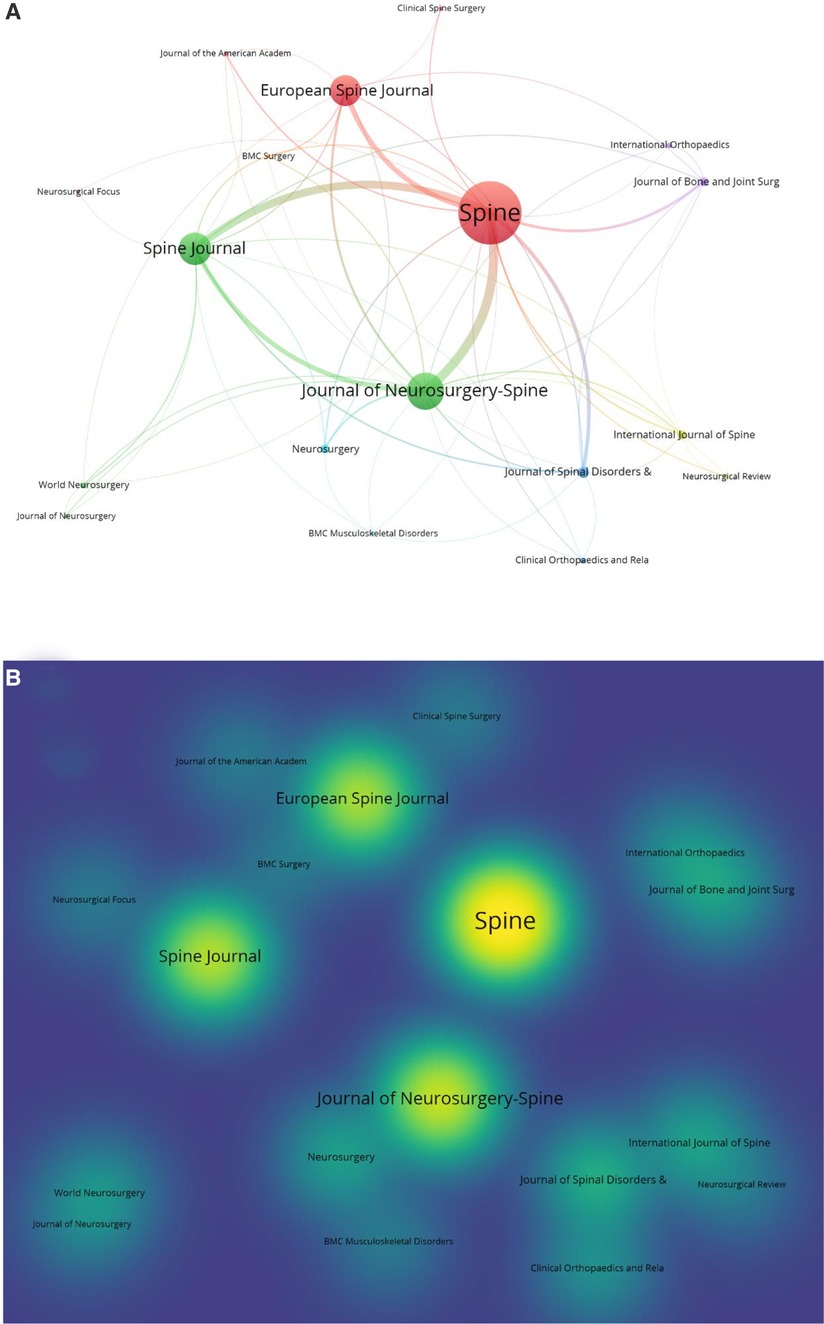
Figure 4. Degree of centrality analysis of the journals of the whole 100 top-cited articles. (A) Overlay visualization. (B) Hotmap overlay visualization.
Ten authors (first author, co-author, or corresponding author) published more than five publications within the top 100 most-cited articles (Table 4). The most prolific author was Todd J. Albert (n = 7), with a total of 1,312 citations, who is a surgeon-in-chief emeritus at the Hospital for Special Surgery and professor of orthopedic surgery at Weill Cornell Medical College (New York, NY, USA). Hyun W. Bae at the Cedars-Sinai Medical Center (Los Angeles, CA, USA) and Michael S. Hisey at the Texas Back Institute (Plano, TX, USA) were the second most prolific authors with six articles each. Alexander R. Vaccaro from the Rothman Institute, Thomas Jefferson University (Philadelphia, PA, USA) had 1,139 total citations, almost the same as Todd J Albert, who is the president of Rothman Orthopaedics and a leading doctor in spine surgery.
Author keywords of all 100 articles were analyzed via VOSviewer network analysis, as shown in Figure 5. The results showed that except for ACDF, cervical, cervical spine and fusion, the keywords adjacent segment degeneration, complications, cervical arthroplasty, degenerative disc disease, arthroplasty, and total disc replacement (TDR) also had a higher degree of centrality (Figure 5A). Furthermore, each node is colored based on when they occurred, in a blue-to-yellow gradient (Figure 5B); this shows that except for ACDF, cervical and complications, the keywords adjacent segment degeneration, adjacent segment disease, TDR, cervical disc replacement, cervical disc arthroplasty, cervical arthroplasty, prodisc-c, multilevel, and clinical outcome have occurred in recent years.
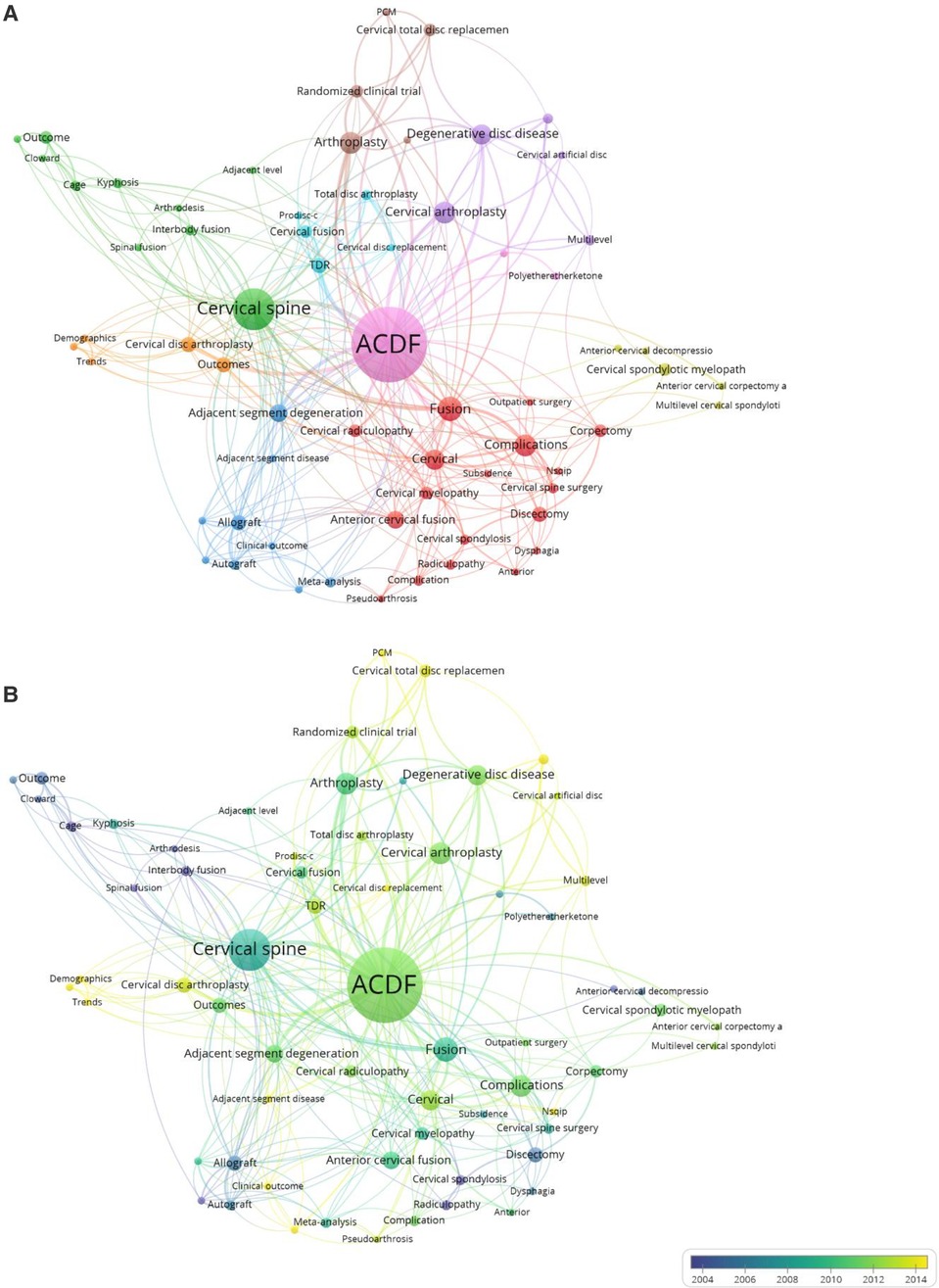
Figure 5. Degree of centrality analysis of the author key words of the whole 100 top-cited articles. (A) Overlay visualization. (B) Time-dependent overlay visualization.
Discussion
The citation number is an important bibliometric indicator and a useful tool to measure the influence of publications. Many bibliometric analysis methods have also been used in various kinds of articles (17). In this study, we aimed to provide a better understanding of the historical knowledge of surgeons regarding ACDF. We also wanted to determine which articles regarding ACDF have been more impactful by identifying and analyzing the characteristics of the 100 most-cited articles.
The top 100 articles on ACDF were cited a mean of 131.81 ± 100.18 times (range, 66–660), which is more than the number of citations in other fields of spine surgery, such as endoscopic spine surgery research (mean, 84.4) (18), spinal disc arthroplasty research (mean, 115.1) (19), adult spinal deformity (mean, 34.8) (20), and idiopathic scoliosis (mean, 137.5) (21). This indicates that ACDF has been studied more frequently than other topics within the field of spine surgery.
Most of the 100 top-cited articles were published in the 2010s (51%) and the 2000s (44%), whereas only 5% were published before 2000. In our experience, older articles tend to have more citations; yet, we obtained the opposite results. This may be explained by the “obliteration by incorporation” concept, whereby a new article that originates from an early influential article gains greater popularity, reducing the citations of the original article (22). However, some researchers believe that articles may show their value 20 years after their publication (23). Moreover, some medical techniques and concepts from articles published before 2000 have been inevitably innovated by new technologies, discoveries, and views. This may explain how the 100 top-cited articles were distributed in different periods, and why the most recent article included in our list was published in 2018. Recently published research requires more time to accumulate citations and establish its significance.
As for the citations in the last five years, we found that some of the 20 top-cited articles only have a few dozen citations, such as ranks 9, 10, 15, 19, and 20 in Table 1. For several articles among the 80–100 top-cited ones, we found that the citation number for the last 5 years almost coincided with the total citation number, such as ranks 89, 90, 92, 93, 95, 98, and 100 (Table 1). Progress in academic concepts, surgical skills, and scientific research may explain this phenomenon and indicate the change in research hotspots in cervical spine surgery.
The most cited article was an investigation of donor site morbidity after anterior iliac crest bone harvest for single-level ACDF surgery by Silber Jeff S. et al. with 660 total citations after publication in 2003, which first focused on complications in the iliac crest bone graft site after single-level ACDF surgery (24). The authors found that a large percentage of patients suffered from chronic donor site pain after surgery, and long-term functional impairment could also be a significant problem. Although the study was published 20 years before, this pivotal study made surgeons aware of the need for alternative sources of graft material. Therefore, different types of interbody implants have been developed, such as hydroxyapatite (HA), polyetheretherketone (PEEK) cage, and titanium (Ti) cage, which have better shape, biomechanical function, and fusion rate (10, 25). This study greatly promoted the development of cervical interbody implants.
In 2007, Fountas Kostas et al. (26) published the second most cited article, a retrospective review, with 604 citations. This article was also about ACDF complications but focused on the ACDF surgery itself. The authors evaluated 1,015 patients undergoing first-time ACDF for cervical radiculopathy and/or myelopathy owing to degenerative disc disease and/or cervical spondylosis and analyzed the most common complications related to ACDF. This article had significant guiding significance for clinical spine surgeons in avoiding iatrogenic injury in ACDF surgery. It is worth mentioning that this article also had the most citations in the last 5 years.
The third most cited article was by Mummaneni Praveen et al. (27), which was also published in 2007. This prospective randomized multicenter study aimed to compare the clinical and radiographic outcomes between ACDF and cervical disc arthroplasty for the treatment of single-level cervical degenerative disc disease. The authors concluded that the PRESTIGE ST Cervical Disc System had more advantages in improving neurological success and clinical outcomes, as well as reducing the rate of secondary surgeries, compared with ACDF at 24 months of follow-up.
Further analysis of the articles revealed that three of the five most-cited articles were related to artificial cervical disc replacement (ADR). This kind of surgery was first proposed by Vincent E Bryan Jr in 2002 (28); since then, different kinds of movable artificial cervical discs like ProDisc-C and Mobi-C were designed and applied in clinical settings (29, 30). The Bryan disc was designed for maintaining the normal biomechanics of the cervical spine, to reduce the incidence of adjacent segment disease (ASD) and degeneration (31–33). With further research, surgeons found that the incidence of ASD was not significantly different between ACDF and ADR surgery (34, 35), but ADR surgery had the advantages of greater cervical spine mobility and less dysphagia. Moreover, the hot keywords in the 2010s were mostly about ADR surgery, which indicates that ADR surgery has huge potential in the future.
Most of the analyzed articles (68%) and journals (68.4%) originated in the United States, same as in the fields of arthroscopy (12), back pain research (36), and hand surgery (37). The inventors of ACDF, G.W. Smith, and R.B. Cloward are both from the United States, where ACDF surgery has spread worldwide. In addition, it is not unthinkable that authors from the United States are more likely to publish in US journals and usually prefer to cite US articles (38).
Regarding the journals, Spine was the most popular journal in the 100 most-cited articles, with 30 articles published in it and with 4,978 citations; three of these articles had over 300 citations. Spine is one of the most well-known and relatively older journals in the field of spine surgery, which may explain why it attracts important articles and receives more citations. The latest impact factor of Spine is 3.468, with a Q1 category quartile in the orthopedic JCR category in 2020.
The Texas Back Institute (TBI) was the most productive research institution, publishing 10 of the 100 top-cited articles. TBI was established in 1977, and surgeons have made great progress in the treatment of spinal diseases in the past 45 years. Michael S. Hisey and Jack E. Zigler, both from TBI, authored all 10 articles, making them the researchers with the most publications on the top 100 list. With their team, they have made significant achievements in cervical total disc replacement (Mobi-C from Zimmer Biomet® and ProDisc-C from Centinel Spine®) and conducted long-term follow-up studies on ACDF under many aspects (33, 39–47). Frank M. Phillips from Rush University is another ACDF pioneer, who also has advanced cervical disc replacement, and these works have made his institution productive (48–52). In addition, Thomas Jefferson University is also a productive research institution in the field of ACDF, and two of its doctors, Todd J. Albert and Alexander R. Vaccaro, are the greatest scholars in spine surgery, and their contribution to the field of ACDF relates to the most common ACDF and cervical disc replacement complications in the 100 top-cited articles (24, 34, 47, 50, 53–56). The scholars mentioned above provided great help and guidance for spine surgeons performing ACDF.
As expected, the most common keywords were ACDF, fusion, and cervical spine. Apart from these, adjacent segment degeneration, complications, cervical arthroplasty, degenerative disc disease, arthroplasty, and TDR were also frequently used keywords in the 100 top-cited articles. In chronological terms, the keywords adjacent segment degeneration, adjacent segment disease, TDR, cervical disc replacement, cervical disc arthroplasty, cervical arthroplasty, prodisc-c, multilevel, and clinical outcome were the most frequently used after 2010.
Surgery complications were always an important topic (57), and it was truly a trending research topic keyword before 2010; however, these keywords were featured relatively less often in the top 100 most-cited articles after 2010. This may be because most complications have been avoided with the directions from previous research and the development of surgical skills. The same phenomenon was observed for keywords such as cage, interbody fusion, cervical fusion, allograft, and anterior cervical decompression, likely for the same reason. In contrast, cervical disc replacement, PCM, Prodisc-c, TDR, adjacent segment disease, and multilevel became hot keywords after 2010. To our knowledge, adjacent segment degeneration after ACDF mostly depends on cervical biomechanical changes around the fusion level, and it could not be solved because of the principles of ACDF surgery (58–60), while ADR surgery can solve this problem in a targeted manner; therefore, we believe it was the reason for the change in hot keywords. The changes in other hot keywords' citation frequency, such as multilevel and clinical outcomes, may depend on the advances in diagnosis and treatment of the disease. In general, cervical disc replacement, adjacent segment disease, and clinical outcomes may be research hotspots for decades to come.
In our study, synthesis of the keywords in the top 100 most-cited articles on ACDF and all of author key words in the papers published over the last 5 years, we forecast the possible study trends in the future may include (1) new cervical interbody implants are the main objects of research, like Zero-profile intervertebral fusion system and 3D-print intervertebral fusion implants, etc.; (2) long time and large sample size follow-up research on new cervical interbody implants are needed in the future and (3) adjacent segment disease (degeneration) continues to be of interest for researchers.
This study has several limitations. First, all articles were identified according to the number of citations; therefore some new, just as relevant publications in the field did not have the same opportunity to be cited often enough to be included in this study. Second, we did not exclude self-citation, as authors prefer to cite articles from the journal with which they intend to publish (61), and the citation number may not completely reflect the research quality. Third, the geographical clustering is limited by the growing level of international collaboration. Besides, the highest quality articles are more likely to compare two techniques or provide evidence-based guidance rather than just focusing on ACDF alone (62). Then, this bibliometric analysis only included published journal articles and other materials, such as clinical guidelines, meeting notes, and textbooks. Finally, authors prefer to cite articles that already have many citations while ignoring quality or content (63).
Conclusion
This study identified and bibliometrically analyzed the 100 most-cited articles on ACDF between 1950 and 2022, including article title, authors, institutions, country, year of publication, journals, keywords, and total number of citations. Our study illustrates that ACDF is an improving and popular research field. Different types of cervical disc replacement skills, how to reduce the incidence of adjacent segment disease, and clinical outcomes may soon become research hotspots. This article provides insight into worldwide research trends and potential directions for future research on ACDF.
Data availability statement
The original contributions presented in the study are included in the article/Supplementary Material, further inquiries can be directed to the corresponding author/s.
Author contributions
Article review was performed by ZYD and JSL, data collection and analysis were performed by YJR and HQC. The first draft of the manuscript was written by ZYD and JSL and all the authors commented on previous versions of the manuscript. All the authors read, approved the final manuscript, and contributed to the study’s conception and design. All authors contributed to the article and approved the submitted version.
Funding
This study was partially supported by the National Natural Science Foundation of China (Grant Nos. 81502331) and the Natural Science Foundation of Hunan Province (Grant Nos. 2021JJ31010). The study supporters played no role in the study design, collection, analysis, and interpretation of data, in the writing of the manuscript, and in the decision to submit the manuscript for publication.
Acknowledgments
We thank Song Wu for his expertise in cervical spine surgery.
Conflict of interest
The authors declare that the research was conducted in the absence of any commercial or financial relationships that could be construed as a potential conflict of interest.
Publisher's note
All claims expressed in this article are solely those of the authors and do not necessarily represent those of their affiliated organizations, or those of the publisher, the editors and the reviewers. Any product that may be evaluated in this article, or claim that may be made by its manufacturer, is not guaranteed or endorsed by the publisher.
References
1. Nouri A, Tetreault L, Singh A, Karadimas SK, Fehlings MG. Degenerative cervical myelopathy: epidemiology, genetics, and pathogenesis. Spine. (2015) 40:E675–93. doi: 10.1097/BRS.0000000000000913
2. Ganau M, Holly LT, Mizuno J, Fehlings MG. Future directions and new technologies for the management of degenerative cervical myelopathy. Neurosurg Clin N Am. (2018) 29:185–93. doi: 10.1016/j.nec.2017.09.006
3. Smith GW, Robinson RA. The treatment of certain cervical-spine disorders by anterior removal of the intervertebral disc and interbody fusion. J Bone Joint Surg Am. (1958) 40-A:607–24. doi: 10.2106/00004623-195840030-00009
4. Cloward RB. The anterior approach for removal of ruptured cervical disks. J Neurosurg. (1958) 15:602–17. doi: 10.3171/jns.1958.15.6.0602
5. Simmons EH, Bhalla SK. Anterior cervical discectomy and fusion. A clinical and biomechanical study with eight-year follow-up. J Bone Joint Surg Br. (1969) 51:225–37. doi: 10.1302/0301-620X.51B2.225
6. Bailey RW, Badgley CE. Stabilization of the cervical spine by anterior fusion. J Bone Joint Surg Am. (1960) 42-A:565–94. doi: 10.2106/00004623-196042040-00001
7. Bagby GW. Arthrodesis by the distraction-compression method using a stainless steel implant. Orthopedics. (1988) 11:931–4. doi: 10.3928/0147-7447-19880601-13
8. Matgé G. Cervical cage fusion with 5 different implants: 250 cases. Acta Neurochir (Wien). (2002) 144(6):539–49. doi: 10.1007/s00701-002-0939-0
9. Scholz M, Schnake KJ, Pingel A, Hoffmann R, Kandziora F. A new zero-profile implant for stand-alone anterior cervical interbody fusion. Clin Orthop Relat Res. (2011) 469:666–73. doi: 10.1007/s11999-010-1597-9
10. Chong E, Pelletier MH, Mobbs RJ, Walsh WR. The design evolution of interbody cages in anterior cervical discectomy and fusion: a systematic review. BMC Musculoskelet Disord. (2015) 16:99. doi: 10.1186/s12891-015-0546-x
11. Weiss HK, Yamaguchi JT, Garcia RM, Hsu WK, Smith ZA, Dahdaleh NS. Trends in national use of anterior cervical discectomy and fusion from 2006 to 2016. World Neurosurg. (2020) 138:e42–51. doi: 10.1016/j.wneu.2020.01.154
12. Tang N, Zhang W, George DM, Wei C, Su Y, Huang T. The top 100 most-cited articles on arthroscopy: most popular topic is rotator cuff rather than cartilage in the last 5 years. Arthroscopy. (2021) 37(6):1779–97. doi: 10.1016/j.arthro.2021.01.039
13. Tang N, Zhang W, George DM, Su Y, Huang T. The top 100 most cited articles on anterior cruciate ligament reconstruction: a bibliometric analysis. Orthop J Sports Med. (2021) 9:2325967120976372. doi: 10.1177/2325967120976372
14. Yin M, Xu C, Mo W. The 100 most cited articles on lumbar spinal stenosis: a bibliometric analysis. Global Spine J. (2022) 12:381–91. doi: 10.1177/2192568220952074
15. Sinha A, Dheerendra S, Munigangaiah S. One hundred top cited articles in cervical myelopathy: a bibliographic analysis. Spine. (2021) 46:E1353–8. doi: 10.1097/BRS.0000000000004100
16. Xie L, Chen Z, Wang H, Zheng C, Jiang J. Bibliometric and visualized analysis of scientific publications on atlantoaxial spine surgery based on web of science and VOSviewer. World Neurosurg. (2020) 137:435–42. doi: 10.1016/j.wneu.2020.01.171.
17. Zupic I, Cater T. Bibliometric methods in management and organization. Organ Res Methods. (2015) 18:429–72. doi: 10.1177/1094428114562629
18. Zhao T, Shen J, Zheng B, Huang Y, Jin M, Morizane K, et al. The 100 most-cited publications in endoscopic spine surgery research. Global Spine J. (2021) 11:587–96. doi: 10.1177/2192568220934740
19. Zhao T, Shen J, Zhang J, Hu X, Morizane K, Huang Y, et al. Top 100 cited articles on spinal disc arthroplasty research. Spine. (2020) 45:1530–6. doi: 10.1097/BRS.0000000000003608
20. Liu P-C, Lu Y, Lin H-H, Yao Y-C, Wang S-T, Chang M-C, et al. Classification and citation analysis of the 100 top-cited articles on adult spinal deformity since 2011: a bibliometric analysis. J Chin Med Assoc. (2022) 85:401–8. doi: 10.1097/JCMA.0000000000000642
21. Gambín-Botella J, Ayala M, Alfonso-Beltrán J, Barrios C. Predominance of studies with poor level of evidence among the top 100 most cited studies on idiopathic scoliosis: a bibliometric and content analysis. Spine Deform. (2018) 6:373–83. doi: 10.1016/j.jspd.2017.12.003
22. Zhang Y, Wumaier M, He D, Xiao B, Zhang J. The 100 top-cited articles on spinal deformity: a bibliometric analysis. Spine. (2020) 45:275–83. doi: 10.1097/BRS.0000000000003247
23. Baltussen A, Kindler CH. Citation classics in anesthetic journals. Anesth Analg. (2004) 98:443–51. doi: 10.1213/01.ANE.0000096185.13474.0A
24. Silber JS, Anderson DG, Daffner SD, Brislin BT, Leland JM, Hilibrand AS, et al. Donor site morbidity after anterior iliac crest bone harvest for single-level anterior cervical discectomy and fusion. Spine. (2003) 28:134–9. doi: 10.1097/00007632-200301150-00008
25. Muthiah N, Yolcu YU, Alan N, Agarwal N, Hamilton DK, Ozpinar A. Evolution of polyetheretherketone (PEEK) and titanium interbody devices for spinal procedures: a comprehensive review of the literature. Eur Spine J. (2022) doi: 10.1007/s00586-022-07272-1 [Epub ahead of print]
26. Fountas KN, Kapsalaki EZ, Nikolakakos LG, Smisson HF, Johnston KW, Grigorian AA, et al. Anterior cervical discectomy and fusion associated complications. Spine. (2007) 32:2310–7. doi: 10.1097/BRS.0b013e318154c57e
27. Mummaneni PV, Burkus JK, Haid RW, Traynelis VC, Zdeblick TA. Clinical and radiographic analysis of cervical disc arthroplasty compared with allograft fusion: a randomized controlled clinical trial. J Neurosurg Spine. (2007) 6:198–209. doi: 10.3171/spi.2007.6.3.198
28. Bryan VE. Cervical motion segment replacement. Eur Spine J. (2002) 11(Suppl 2):S92–7. doi: 10.1007/s00586-002-0437-3
29. DiAngelo DJ, Foley KT, Morrow BR, Schwab JS, Song J, German JW, et al. In vitro biomechanics of cervical disc arthroplasty with the ProDisc-C total disc implant. Neurosurg Focus. (2004) 17:E7.15636563
30. Kim SH, Shin HC, Shin DA, Kim KN, Yoon DH. Early clinical experience with the mobi-C disc prosthesis. Yonsei Med J. (2007) 48:457–64. doi: 10.3349/ymj.2007.48.3.457
31. Gandhi AA, Kode S, DeVries NA, Grosland NM, Smucker JD, Fredericks DC. Biomechanical analysis of cervical disc replacement and fusion using single level, two level, and hybrid constructs. Spine. (2015) 40:1578–85. doi: 10.1097/BRS.0000000000001044
32. Lei T, Liu Y, Wang H, Xu J, Ma Q, Wang L, et al. Clinical and radiological analysis of Bryan cervical disc arthroplasty: eight-year follow-up results compared with anterior cervical discectomy and fusion. Int Orthop. (2016) 40:1197–203. doi: 10.1007/s00264-015-3098-7
33. Murrey D, Janssen M, Delamarter R, Goldstein J, Zigler J, Tay B, et al. Results of the prospective, randomized, controlled multicenter Food and Drug Administration investigational, device exemption study of the ProDisc-C total disc replacement versus anterior discectomy and fusion for the treatment of 1-level symptomatic cervical disc disease. Spine Journal. (2009) 9:275–86. doi: 10.1016/j.spinee.2008.05.006
34. Verma K, Gandhi SD, Maltenfort M, Albert TJ, Hilibrand AS, Vaccaro AR, et al. Rate of adjacent segment disease in cervical disc arthroplasty versus single-level fusion: meta-analysis of prospective studies. Spine. (2013) 38:2253–7. doi: 10.1097/BRS.0000000000000052
35. Dong L, Xu Z, Chen X, Wang D, Li D, Liu T, et al. The change of adjacent segment after cervical disc arthroplasty compared with anterior cervical discectomy and fusion: a meta-analysis of randomized controlled trials. Spine J. (2017) 17:1549–58. doi: 10.1016/j.spinee.2017.06.010
36. Huang W, Wang L, Wang B, Yu L, Yu X. Top 100 cited articles on back pain research: a citation analysis. Spine. (2016) 41:1683–92. doi: 10.1097/BRS.0000000000001736
37. Joyce CW, Kelly JC, Carroll SM. The 100 top-cited classic papers in hand surgery. J Plast Surg Hand Surg. (2014) 48:227–33. doi: 10.3109/2000656X.2013.840640
38. Campbell FM. National bias: a comparison of citation practices by health professionals. Bull Med Libr Assoc. (1990) 78:376–82. PMID: 2224301
39. Zigler JE, Delamarter R, Murrey D, Spivak J, Janssen M. ProDisc-C and anterior cervical discectomy and fusion as surgical treatment for single-level cervical symptomatic degenerative disc disease five-year results of a food and drug administration study. Spine. (2013) 38:203–9. doi: 10.1097/BRS.0b013e318278eb38
40. Davis RJ, Nunley PD, Kim KD, Hisey MS, Jackson RJ, Bae HW, et al. Two-level total disc replacement with Mobi-C cervical artificial disc versus anterior discectomy and fusion: a prospective, randomized, controlled multicenter clinical trial with 4-year follow-up results. J Neurosurg Spine. (2015) 22:15–25. doi: 10.3171/2014.7.SPINE13953
41. Davis RJ, Kim KD, Hisey MS, Hoffman GA, Bae HW, Gaede SE, et al. Cervical total disc replacement with the Mobi-C cervical artificial disc compared with anterior discectomy and fusion for treatment of 2-level symptomatic degenerative disc disease: a prospective, randomized, controlled multicenter clinical trial. J Neurosurg Spine (2013) 19:532–45. doi: 10.3171/2013.6.SPINE12527
42. Delamarter RB, Zigler J. Five-year reoperation rates, cervical total disc replacement versus fusion, results of a prospective randomized clinical trial. Spine. (2013) 38:711–7. doi: 10.1097/BRS.0b013e3182797592
43. Janssen ME, Zigler JE, Spivak JM, Delamarter RB, Darden BV II, Kopjar B. ProDisc-C total disc replacement versus anterior cervical discectomy and fusion for single-level symptomatic cervical disc disease seven-year follow-up of the prospective randomized US food and drug administration investigational device exemption study. J Bone Jt Surg Am Vol. (2015) 97A:1738–47. doi: 10.2106/JBJS.N.01186
44. Hisey MS, Bae HW, Davis RJ, Gaede S, Hoffman G, Kim KD, et al. Prospective, randomized comparison of cervical total disk replacement versus anterior cervical fusion results at 48 months follow-up. J Spinal Disord Tech. (2015) 28:E237–43. doi: 10.1097/BSD.0000000000000185
45. Hisey MS, Zigler JE, Jackson R, Nunley PD, Bae HW, Kim KD, et al. Prospective, randomized comparison of one-level Mobi-C cervical total disc replacement vs. anterior cervical discectomy and fusion: results at 5-year follow-up. Int J Spine Surg. (2016) 10:10. doi: 10.14444/3010
46. Hisey MS, Bae HW, Davis R, Gaede S, Hoffman G, Kim K, et al. Multi-center, prospective, randomized, controlled investigational device exemption clinical trial comparing Mobi-C Cervical Artificial Disc to anterior discectomy and fusion in the treatment of symptomatic degenerative disc disease in the cervical spine. Int J Spine Surg. (2014) 8:7. doi: 10.14444/1007
47. Radcliff K, Davis RJ, Hisey MS, Nunley PD, Hoffman GA, Jackson RJ, et al. Long-term evaluation of cervical disc arthroplasty with the Mobi-C(C) cervical disc: a randomized, prospective, multicenter clinical trial with seven-year follow-up. Int J Spine Surg. (2017) 11(4):31. doi: 10.14444/4031
48. Phillips FM, Geisler FH, Gilder KM, Reah C, Howell KM, McAfee PC. Long-term outcomes of the US FDA IDE prospective, randomized controlled clinical trial comparing PCM cervical disc arthroplasty with anterior cervical discectomy and fusion. Spine. (2015) 40:674–83. doi: 10.1097/BRS.0000000000000869
49. Phillips FM, Lee JYB, Geisler FH, Cappuccino A, Chaput CD, DeVine JG, et al. A prospective, randomized, controlled clinical investigation comparing PCM cervical disc arthroplasty with anterior cervical discectomy and fusion 2-year results from the US FDA IDE clinical trial. Spine. (2013) 38:E907–18. doi: 10.1097/BRS.0b013e318296232f
50. McAfee PC, Cappuccino A, Cunningham BW, Devine JG, Phillips FM, Regan JJ, et al. Lower incidence of dysphagia with cervical arthroplasty compared with ACDF in a prospective randomized clinical trial. J Spinal Disord Tech. (2010) 23:1–8. doi: 10.1097/BSD.0b013e31819e2ab8
51. Park DK, Lin EL, Phillips FM. Index and adjacent level kinematics after cervical disc replacement and anterior fusion in vivo quantitative radiographic analysis. Spine. (2011) 36:721–30. doi: 10.1097/BRS.0b013e3181df10fc
52. Saifi C, Fein AW, Cazzulino A, Lehman RA, Phillips FM, An HS, et al. Trends in resource utilization and rate of cervical disc arthroplasty and anterior cervical discectomy and fusion throughout the United States from 2006 to 2013. Spine Journal. (2018) 18:1022–9. doi: 10.1016/j.spinee.2017.10.072
53. Riley LH, Skolasky RL, Albert TJ, Vaccaro AR, Heller JG. Dysphagia after anterior cervical decompression and fusion - prevalence and risk factors from a longitudinal cohort study. Spine. (2005) 30:2564–9. doi: 10.1097/01.brs.0000186317.86379.02
54. Rihn JA, Kane J, Albert TJ, Vaccaro AR, Hilibrand AS. What is the incidence and severity of dysphagia after anterior cervical surgery? Clin Orthop Relat Res. (2011) 469:658–65. doi: 10.1007/s11999-010-1731-8
55. Radcliff K, Coric D, Albert T. Five-year clinical results of cervical total disc replacement compared with anterior discectomy and fusion for treatment of 2-level symptomatic degenerative disc disease: a prospective, randomized, controlled, multicenter investigational device exemption clinical trial. J. Neurosurg Spine. (2016) 25:213–24. doi: 10.3171/2015.12.SPINE15824
56. Vaccaro A, Beutler W, Peppelman W, Marzluff JM, Highsmith J, Mugglin A, et al. Clinical outcomes with selectively constrained SECURE-C cervical disc arthroplasty two-year results from a prospectivei, randomized, controlled, multicenter investigational device exemption study. Spine. (2013) 38:2227–39. doi: 10.1097/BRS.0000000000000031
57. Ratliff JK, Lebude B, Albert T, Anene-Maidoh T, Anderson G, Dagostino P, et al. Complications in spinal surgery: comparative survey of spine surgeons and patients who underwent spinal surgery. J Neurosurg Spine. (2009) 10:578–84. doi: 10.3171/2009.2.SPINE0935
58. Hashimoto K, Aizawa T, Kanno H, Itoi E. Adjacent segment degeneration after fusion spinal surgery-a systematic review. Int Orthop. (2019) 43:987–93. doi: 10.1007/s00264-018-4241-z
59. Helgeson MD, Bevevino AJ, Hilibrand AS. Update on the evidence for adjacent segment degeneration and disease. Spine J. (2013) 13:342–51. doi: 10.1016/j.spinee.2012.12.009
60. Hilibrand AS, Robbins M. Adjacent segment degeneration and adjacent segment disease: the consequences of spinal fusion? Spine J. (2004) 4:190S–4S. doi: 10.1016/j.spinee.2004.07.007
61. Mavrogenis AF, Ruggieri P, Papagelopoulos PJ. Self-citation in publishing. Clin Orthop Relat Res. (2010) 468:2803–7. doi: 10.1007/s11999-010-1480-8
62. Kato S, Ganau M, Fehlings MG. Surgical decision-making in degenerative cervical myelopathy - anterior versus posterior approach. J Clin Neurosci. (2018) 58:7–12. doi: 10.1016/j.jocn.2018.08.046
Keywords: anterior cervical discectomy and fusion, ACDF, bibliometric analysis, most cited articles, top 100
Citation: Ding Z, Ren Y, Cao H and Li J (2022) Top 100 most cited articles on anterior cervical discectomy and fusion. Front. Surg. 9:1000360. doi: 10.3389/fsurg.2022.1000360
Received: 22 July 2022; Accepted: 18 August 2022;
Published: 6 September 2022.
Edited by:
Mario Ganau, Oxford University Hospitals NHS Trust, United KingdomReviewed by:
Amir Panezai, Nottingham University Hospitals NHS Trust, United KingdomSean Martin, University of Oxford, United Kingdom
Sami Ridwan, Klinikum Ibbenbueren, Germany
© 2022 Ding, Ren, Cao and Li. This is an open-access article distributed under the terms of the Creative Commons Attribution License (CC BY). The use, distribution or reproduction in other forums is permitted, provided the original author(s) and the copyright owner(s) are credited and that the original publication in this journal is cited, in accordance with accepted academic practice. No use, distribution or reproduction is permitted which does not comply with these terms.
*Correspondence: Jinsong Li amluc29uZ2xpQGNzdS5lZHUuY24=
†These authors have contributed equally to this work.
Specialty Section: This article was submitted to Neurosurgery, a section of the journal Frontiers in Surgery
 Zhiyu Ding
Zhiyu Ding Yijun Ren
Yijun Ren Hongqing Cao3
Hongqing Cao3
